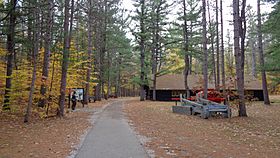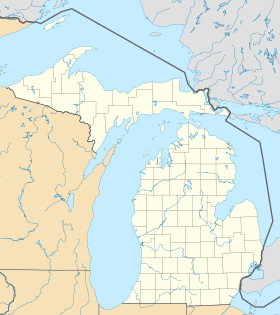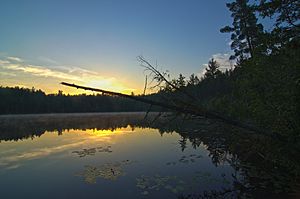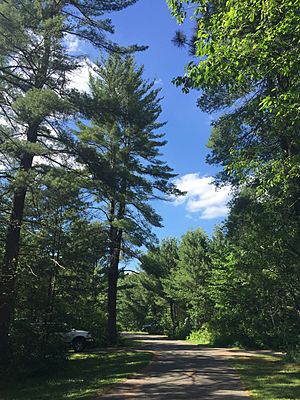Hartwick Pines State Park facts for kids
Quick facts for kids Hartwick Pines State Park |
|
|---|---|
|
IUCN Category V (Protected Landscape/Seascape)
|
|

Hartwick Pines Logging Museum
|
|
| Location | Grayling Charter Township, Crawford County, Michigan, USA |
| Nearest city | Grayling, Michigan |
| Area | 9,762 acres (3,951 ha) |
| Elevation | 1,250 feet (380 m) |
| Designation | Michigan state park |
| Established | 1927 |
| Administrator | Michigan Department of Natural Resources |
| Website | Hartwick Pines State Park |
Hartwick Pines State Park is a large park in Michigan, USA. It covers about 9,762 acres. You can find it near Grayling, in Crawford County. This park is special because it has a very old forest. This forest is full of huge white pines and red pines. It looks like Michigan did before people started cutting down many trees.
Contents
History of Hartwick Pines
How the Park Started
The Hartwick Pines are a 49-acre part of an old pine forest. In 1927, a company decided not to cut down these trees. At that time, very few old pine trees were left in northern Michigan.
Karen Michelson Hartwick was an heir to the company's owners. She gave this forest to the state of Michigan. It was 85 acres then. She also donated 8,000 acres of land that had already been cut. This gift was a way to remember the logging industry.
Growing Back the Forest
The Sallin Hansen Lumber Company cut down many trees in the park area. This happened in the 1880s and 1890s. Later, in the 1930s, the Civilian Conservation Corps (CCC) planted many new trees. The CCC was a group of young men who worked on conservation projects during the Great Depression. Because of their work, much of this forest is now called "second growth."
The Big Storm of 1940
On November 11, 1940, a huge snowstorm hit. It was called the Armistice Day Blizzard. This storm badly damaged the old pine forest at Hartwick Pines. About 36 acres of old trees were blown down. This left the 49 acres of old trees that you can see today.
Hartwick Pines Logging Museum
The Hartwick Pines Logging Museum was built by the Civilian Conservation Corps (CCC). It was finished in 1934–1935. The museum shows what logging camps were like. It has recreated rooms, old photos, and tools from the time when Michigan had a big lumber industry.
The museum is in two buildings that look like old logging camp structures. Outside, you can see logging equipment. There is also a steam-powered sawmill. This sawmill is operated during special events in the summer. The Michigan Department of Natural Resources helps manage the museum.
Things to Do at the Park
Michigan Forest Visitor Center
The Michigan Forest Visitor Center is a great place to start your visit. It has exhibits about the history of Michigan's forests. There is also an auditorium and classrooms. You can find a bookstore run by the Friends of Hartwick Pines.
The visitor center has a large auditorium. It can seat 105 people. You can watch a 14-minute slide show there. This show tells the story of logging from the past to today. The park also offers programs and special events all year long.
Camping and Trails
The state park has a campground where you can stay overnight. There is also a day-use area for picnics and other activities. The park has many trails for hiking in the summer. In the winter, you can use them for cross-country skiing.
The Old Growth Forest Trail leads to the special pine grove. This trail is a loop about 1.25 miles (2 km) long. The Old Growth Forest has pines that are all about the same age. They are estimated to be between 350 and 375 years old. The tallest trees are about 150–160 feet tall. Their trunks are more than four feet wide. These eastern white pines are some of the biggest trees in the eastern United States.
There are two other foot trails on the south side of M-93. The Au Sable River foot trail is about three miles long. It takes hikers across the East Branch of the river in two spots. The Mertz Grade Trail winds through forests and fields for about two miles. It was named after an old logging railroad track it follows for part of its path.
Park Lakes
There are four small lakes inside the state park. Two of them were first called Bright and Star Lake. But because there were too many "Star Lakes," they changed the name. Now, they are called Bright Lake and Glory Lake.




